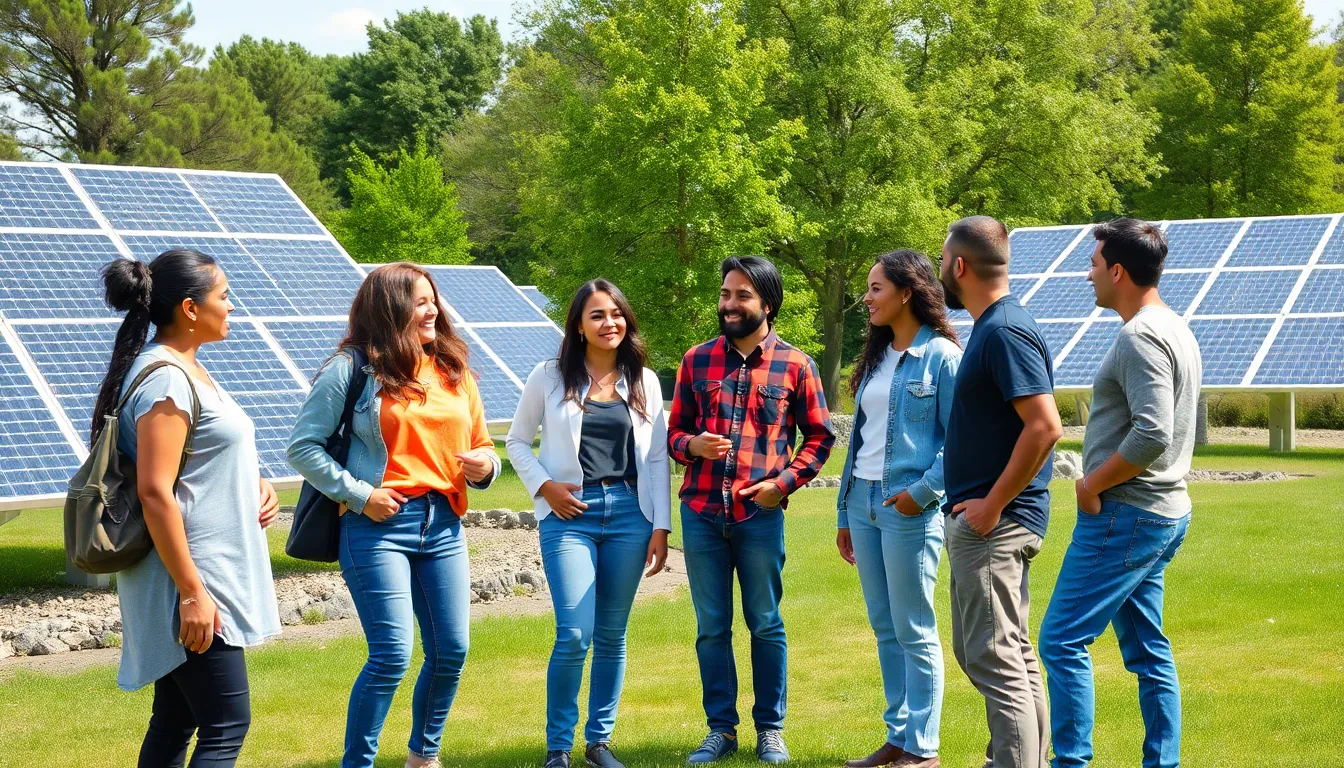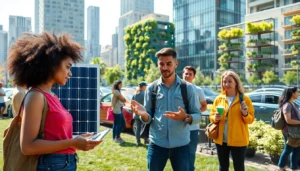Table of Contents
ToggleIn a world where energy demands are skyrocketing, the need for effective energy conservation has never been more critical. As resources dwindle and environmental concerns rise, individuals and businesses alike are recognizing the importance of reducing energy consumption. By adopting simple yet impactful practices, everyone can play a role in creating a sustainable future.
Energy conservation isn’t just about saving money on utility bills; it’s about making a conscious effort to protect the planet. From switching off lights when not in use to investing in energy-efficient appliances, every small action contributes to a larger goal. Embracing these habits not only fosters a sense of responsibility but also paves the way for innovative solutions that can reshape how society approaches energy use.
Overview Of Energy Conservation
Energy conservation involves strategies and practices aimed at reducing energy consumption to promote sustainability and protect the environment. Energy conservation is crucial as global energy demands continue to rise, leading to increased greenhouse gas emissions and resource depletion.
Individuals and businesses can make significant contributions to energy conservation. Simple actions, such as switching off lights when not in use, utilizing energy-efficient appliances, and optimizing heating and cooling systems, significantly lower energy consumption. Each decision has a measurable impact. For instance, replacing incandescent bulbs with LED bulbs can reduce energy use by up to 75%.
Education plays an essential role in promoting energy-saving habits. Awareness campaigns can inform the public about the benefits of energy conservation, encouraging proactive behaviors. Organizations dedicated to sustainability offer resources and tips for reducing overall energy use.
By prioritizing energy conservation, communities can work toward a sustainable future. Collective efforts help to decrease dependency on fossil fuels, enhance energy security, and mitigate climate change. Each small improvement in energy efficiency contributes to the larger goal of environmental protection.
Importance Of Energy Conservation

Energy conservation plays a crucial role in ensuring a sustainable future. It offers significant environmental benefits and economic advantages that impact individuals, businesses, and communities.
Environmental Benefits
Energy conservation reduces greenhouse gas emissions, contributing to lower global warming potential. By decreasing energy demand, it lessens the extraction and burning of fossil fuels, which leads to air and water pollution. For instance, energy-efficient practices can reduce carbon dioxide emissions by over 1,400 pounds per year for an average household that switches to LED lighting. Additionally, conserving energy helps protect ecosystems by minimizing resource depletion. Fewer energy resources used translates to less habitat destruction, preserving biodiversity.
Economic Advantages
Energy conservation leads to substantial cost savings for both individuals and businesses. When households adopt energy-efficient appliances, they can save an average of $500 annually on energy bills. Businesses that invest in energy-saving technologies often experience reduced operational costs and increased competitiveness. Furthermore, energy conservation creates job opportunities in sectors focused on energy efficiency and renewable energy. Research indicates that every $1 million invested in energy efficiency creates approximately 17 jobs. As energy costs fluctuate, conserving energy enhances financial stability and promotes long-term economic growth.
Methods Of Energy Conservation
Energy conservation methods encompass a variety of practices tailored for residential and commercial settings, promoting efficient energy use.
Residential Practices
Residential energy conservation entails simple yet effective actions that homeowners can adopt.
- Switch to LED lighting: LED bulbs consume up to 75% less energy than incandescent bulbs and last up to 25 times longer.
- Adjust thermostat settings: Setting thermostats to 68°F in winter and 78°F in summer optimizes heating and cooling efficiency.
- Use energy-efficient appliances: Energy Star-rated appliances can reduce electricity consumption by 10-50%, depending on the type.
- Seal windows and doors: Proper insulation prevents air leaks, enhancing heating and cooling efficiency.
- Unplug idle electronics: Devices in standby mode account for about 10% of residential energy use; unplugging them saves energy.
These practices can lead to significant reductions in energy consumption and costs while promoting environmental sustainability.
Commercial Strategies
Commercial energy conservation strategies focus on optimizing operations through efficiency.
- Implement energy management systems: These systems monitor and control energy use, reducing consumption by up to 30%.
- Upgrade to energy-efficient lighting: Replacing traditional fixtures with LED lighting can lower lighting costs by 50-75%.
- Improve HVAC systems: Regular maintenance and upgrades to energy-efficient heating and cooling systems can reduce energy use by 20-50%.
- Utilize programmable thermostats: These thermostats adjust temperatures based on occupancy, saving energy during non-business hours.
- Encourage employee engagement: Promoting energy-saving practices among staff can enhance overall conservation efforts within the organization.
Adopting these commercial strategies not only decreases energy costs but also improves corporate responsibility and public image.
Challenges In Energy Conservation
Energy conservation faces several challenges that can hinder its effectiveness and widespread adoption. Key obstacles include awareness and education gaps as well as technological limitations.
Awareness and Education
Awareness and education significantly impact energy conservation efforts. Many individuals lack knowledge about energy-saving practices and their benefits. Limited understanding leads to lower participation in energy-efficient programs. Educational initiatives can promote awareness of energy conservation strategies, but often, these programs aren’t widely available or accessible. Informed communities are more likely to adopt energy-efficient habits, resulting in measurable reductions in consumption. Without effective education campaigns, misconceptions about energy conservation persist, making it difficult to drive collective action.
Technological Limitations
Technological limitations present another challenge for energy conservation. While numerous energy-saving technologies exist, many households and businesses face barriers to accessing these innovations. High upfront costs for energy-efficient appliances and systems deter investment. Additionally, older infrastructures may not support the integration of advanced technologies, leading to inefficiencies. In some regions, a lack of reliable renewable energy sources limits options for sustainable practices. Overcoming these technological challenges requires targeted investments and supportive policies to enhance the availability and affordability of energy-efficient solutions.
Future Of Energy Conservation
The future of energy conservation hinges on innovation, policy advancement, and increased awareness. With technological advancements, energy-efficient solutions become more accessible. Smart technologies such as smart meters and energy management systems optimize energy use, allowing real-time monitoring and adjustments. These innovations enhance efficiency and reduce waste, promoting a more sustainable environment.
Policies supporting energy conservation will play a crucial role. Governments can implement incentives for adopting energy-efficient practices and technologies, encouraging individuals and businesses to invest. Furthermore, regulations mandating energy efficiency standards for appliances, buildings, and vehicles can significantly lower overall energy consumption.
Education and awareness also shape the future landscape. Public campaigns focused on the benefits of energy conservation can motivate proactive participation. Schools and communities can introduce energy conservation programs, fostering long-term habits in future generations.
Collaborations among private and public sectors will accelerate progress. Partnerships can lead to the development of renewable energy projects and efficiency programs. By combining resources and expertise, both sectors can drive significant advancements while creating a collective impact on energy consumption.
Investment in research and development will further improve energy conservation techniques. New methods and technologies can emerge to address existing barriers, fostering better energy efficiency. Outcomes from this investment can yield breakthroughs that make energy conservation not only feasible but also economically beneficial.
A commitment from individuals and corporations to embrace energy conservation strengthens the movement toward sustainability. Each contribution, whether small or large, plays a vital role in shaping a greener future. As energy demands rise, and the effects of climate change become more pronounced, the importance of effective energy conservation strategies cannot be overstated.
Energy conservation is more than just a trend; it’s a necessity for a sustainable future. By embracing simple yet effective practices, individuals and businesses can make a significant impact on both their energy bills and the environment. The commitment to reducing energy consumption fosters a healthier planet and creates economic opportunities through job growth in energy efficiency sectors.
As awareness grows and technology advances, the potential for energy conservation continues to expand. Each action taken contributes to a collective movement towards reducing greenhouse gas emissions and preserving natural resources. By prioritizing energy conservation today, communities can pave the way for a cleaner and more sustainable tomorrow.







